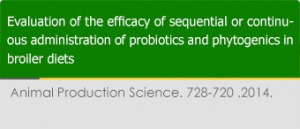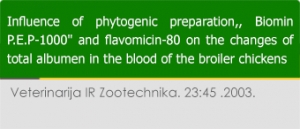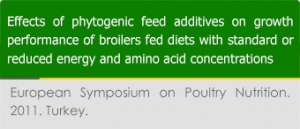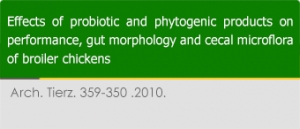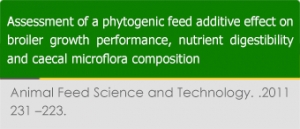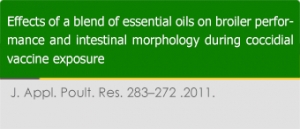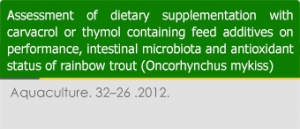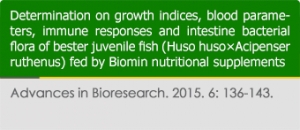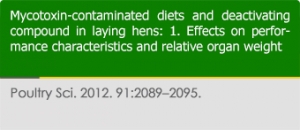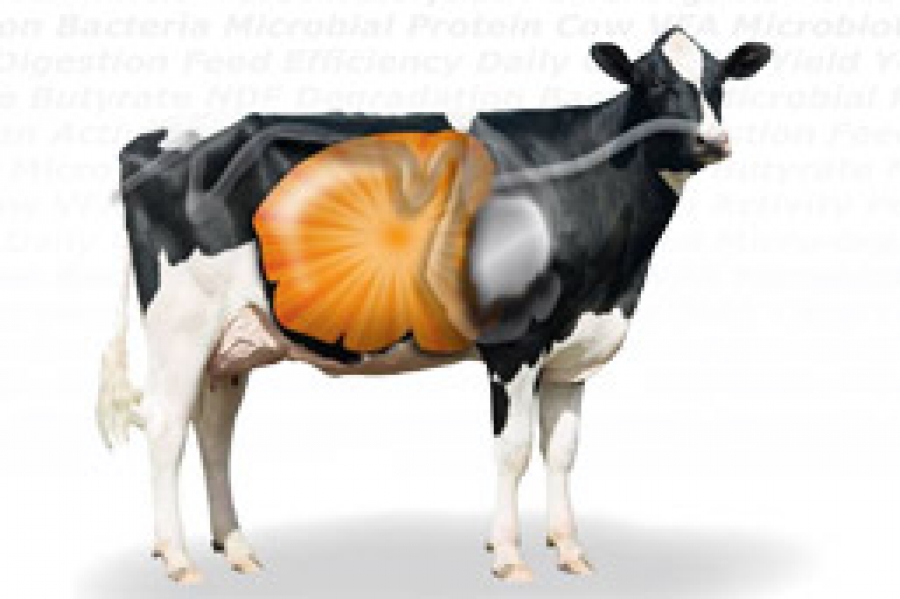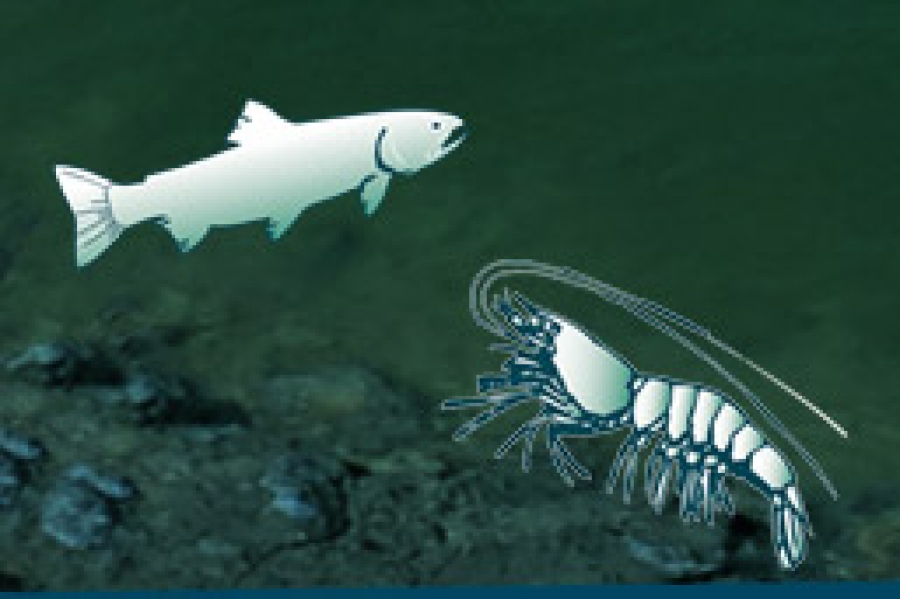K. C. Mountzouris, P. Tsirtsikos, G. Papadomichelakis, G. Schatzmayr and K. Fegeros
Three dietary combinations of probiotics and phytogenics administered sequentially or continuously were assessed for their effects on broiler performance, nutrient digestibility, caecal microbiota composition, volatile fatty acid (VFA) pattern and plasma total antioxidant capacity (TAC). One-day-old Cobb male broilers (n = 525) were allocated to five experimental treatments for 42 days. Each treatment had three replicates of 35 broilers each. Depending on the time-frame of sequential or continuous addition in the basal diet (BD) of the probiotics (108 CFU/kg BD) and phytogenics (125 mg/kg BD), experimental treatments were: control (no additions, Days 1–42); PE1, probiotic Days 1–14 and phytogenic Days 15–42; PE2, probiotic Days 1–28 and phytogenic Days 29–42; PE3,
Sirvydis v., Sabalionyte R., Bobiniene R., Gruzauskas R.
The aim of the research is to investigate the influence of phytogenic preparation „Biomin P.E.P – 1000“, which is of a natural origin, on the processes of albumen metabolism in the organism of broiler chickens. Biomin P.E.P – 1000 positively stimulates the activity of the alimentary tract of broiler chickens as well as a composition of intestine micro flora, consequently that conditions better digestion of nutrient substances. 3 groups of broiler chickens were researched. The chickens of the first group were fed with the feed mixture, containing a feeding antibiotic Flavomicin-80, in the feed of the second group of chickens a feeding antibiotic Flavomicin – 80 was replaced by a dry phytogenic preparation „Biomin P.E.P–1000“, and in the drinking water of the chickens of the third group a liquid phytogenic preparation,
Tobias Steinera, Lidija Peric, Sinisa Bjedov, Niko Milosevic
The effects of dietary supplementation with two phytogenic feed additives (PFA) on performance parameters were investigated using 1200 mixed sex broilers fed standard diets or diets with reduced energy and amino acid concentrations. Birds were assigned to 6 treatments with 5 replications each and either fed a standard basal diet or a re-formulated basal diet with 1.5% reduced energy and amino acid concentrations. Treatments were: (1) Standard diet; (2) as 1 + PFA-1; (3) as 1 + PFA-2; (4) Re-formulated diet; (5) as 4 + PFA-1; (6) as 4 + PFA-2. PFA-1 was a blend of essential oils from oregano, anise and citrus adsorbed to an organic carrier (dosage: 0.125 g/kg) and PFA-2 was blend of essential oils from oregano, thyme, anise and citrus, encapsulated in a carbohydrate matrix (dosage: 0.1 g/kg).
L. Peric, N. Milosevic, D. Zikic, S. Bjedov, D. Cvetkovic, S. Markov, M. Mohnl and T. Steuner
The trial involved 684 Cobb 500 broiler chicks in order to investigate the effects of probiotics and phytogenic additives on performance, gut morphology and cecal microbial concentrations. Birds were assigned to three treatments: control feed, treatment with addition of probiotics in feed and water and treatment with addition of phytogenic blend in feed. The results showed a significant improvement (P<0.01) in body weight gain and a numerical, but non significant (P>0.05) improvement in feed conversion ratio by adding both probiotics and phytogenics in feed. There were no statistically significant differences among treatments regarding total aerobes, anaerobes, lactic acid bacteria, bifidobacteria, enterococci, and Escherichia coli populations (P>0.05) in cecum of broilers.
K.C. Mountzourisa, V. Paraskevas, P. Tsirtsikos, I. Palamidi, T. Steiner, G. Schatzmayr, K. Fegeros
The aim of this work was to evaluate the effect of three inclusion levels of a phytogenic feed additive (PFA) comprising a blend of essential oils from oregano, anise and citrus on broiler growth performance, nutrient digestibility and caecal microflora composition. Five hundred and twenty-five, 1-day-old, male Cobb broilers received a maize–soybean meal basal diet (BD) and depending on the type of addition were allocated in the following five experimental treatments for 6 weeks: BD–no additives (C), BD containing 80 mg PFA/kg diet (E1), BD containing 125 mg PFA/kg diet (E2), BD containing 250 mg PFA/kg diet (E3) and BD containing avilamycin at 2.5 mg/kg diet (A). Treatment A was used as a positive control due to the well-known function of avilamycin as an antimicrobial growth promoter in poultry.
N. Reisinger, T. Steiner, S. Nitsch, G. Schatzmayr, and T. J. Applegate
A 2 × 2 factorial experiment (8 pens/treatment, 26 birds/pen) was conducted with 2 doses of a coccidial vaccine [1× or 5× (Paracox-5, Schering-Plough Animal Health, Uxbridge, UK)], administered at 1 d of age) with or without supplementation (125 g/1,000 kg) with a phytogenic feed additive containing a blend of essential oils from oregano, anise, and citrus peel [Biomin P.E.P. 125 poultry (Biomin GmbH, Herzogenburg, Austria); EO]. Within each pen, 13 birds received the coccidial vaccine, whereas the remainder were naturally exposed through the recycling of oocysts in the litter. In pens of birds receiving the higher (5×) dosage of coccidial vaccine, the BW of broilers decreased by up to 2.7% (P = 0.08), but feed-to-gain ratio (FCR) and mortality at 27 d of age (P > 0.05) were not affected.
I. Giannenas, El. Triantafillou, S. Stavrakakis, M. Margaroni c, S. Mavridis, T. Steiner, E. Karagouni
The manipulation and control of fish health and production by natural substances has been identified as an important area for future developments in aquaculture. A study was conducted to investigate the effect of two phytogenic feed additives, one rich in carvacrol (CARV containing 12 g/kg carvacrol) and the other rich in thymol (THYM containing 6 g/kg thymol) on growth performance, gut microbiota and antioxidant status of rainbow trout (Oncorhynchus mykiss) under commercial farming conditions. Groups of 30 sub-adult trout (113.0 g ± 10.4) were randomly allocated into 3 different treatments with three replicates each. The control group was fed a basal diet, while the other two groups were fed diets supplemented with the two phytogenic diets at the level of 1 g/kg.
Fariborz Taghavi, Mehrdad Nasri Tajan, Abbas Ali Zamini
This study is evaluated the effects of Biomin P.E.P supplement on growth indices, blood and immune factors, and intestine bacterial flora of Bester juvenile fish. The survey is conducted on Bester juvenile sturgeons in fisheries laboratory located in Islamic Azad University Science and Research of Guilan Branch in the fall of 1392. The completely random scheme of the research includes 4 treatments each of which has 3 repetitions. The supplement was added to the basal diet on 4 levels of 0, 1, 1/5, and 2 g / kg.72 of 45-g Bester fish were fed for 60 days based on 5 percent of the body weight in 12 tanks (100-liter) that 6 fish in each tank. At the end of the farming period some of the growth indices, blood and immune factors, and intestine bacterial flora were compared.
Lee, J. T., K. A. Jessen, R. Beltran, V. Starkl, G. Schatzmayr, R. Borutova, and D. J. Caldwell
The current experiment was conducted to determine the effect of mycotoxin-contaminated diets with aflatoxin (AFLA) and deoxynivalenol (DON) and dietary inclusion of deactivation compound on layer hen performance during a 10-wk trial. The experimental design consisted of a 4 × 2 factorial with 4 toxin levels: control, low (0.5 mg/kg AFLA + 1.0 mg/kg DON), medium (1.5 mg/kg AFLA + 1.5 mg/kg DON), and high (2.0 mg/kg AFLA + 2.0 mg/kg DON) with or without the inclusion of deactivation compound. Three hundred eighty-four 25-wk-old laying hens were randomly assigned to 1 of the 8 treatment groups. Birds were fed contaminated diets for a 6-wk phase of toxin administration followed by a 4-wk recovery phase, when all birds were fed mycotoxin-free diets.
Lee, J. T., K. A. Jessen, R. Beltran, V. Starkl, G. Schatzmayr, R. Borutova, and D. J. Caldwell
An experiment was conducted to determine the effect of dietary inclusion of Mycofix Select (Biomin GmbH, Herzogenburg, Austria) on discrete egg parameters and quality characteristics of hens fed mycotoxin-contaminated diets (aflatoxin; AFLA) and deoxynivalenol (DON)) during a 10-wk trial. A 4 × 2 factorial design was used with 4 contamination levels: control, low (0.5 mg/kg of AFLA + 1.0 mg/kg of DON), medium (1.5 mg/kg of AFLA + 1.5 mg/kg of DON), and high (2.0 mg/kg of AFLA + 2.0 mg/kg of DON) with or without the inclusion of mycotoxin deactivating compound. Three hundred and eighty-four 25-wk-old laying hens were housed 3 per cage. Birds were fed contaminated diets for a 6-wk phase of toxin administration followed by a 4-wk recovery phase, when all birds were fed mycotoxin-free diets.



